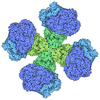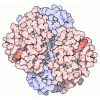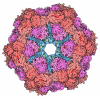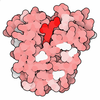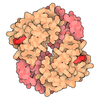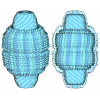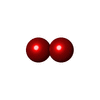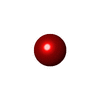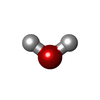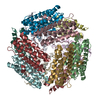[English] 日本語
 Yorodumi
Yorodumi- PDB-9e8s: Structure of thioferritin (PfDPSL) with ferrihydrite growth at a ... -
+ Open data
Open data
- Basic information
Basic information
| Entry | Database: PDB / ID: 9e8s | ||||||
|---|---|---|---|---|---|---|---|
| Title | Structure of thioferritin (PfDPSL) with ferrihydrite growth at a single three-fold pore. | ||||||
 Components Components | DNA protection during starvation protein | ||||||
 Keywords Keywords | METAL BINDING PROTEIN / Ferritin / thioferritin / oxidative stress / iron homeostasis / iron mineral / ferric oxyhydroxide / mineral core / protein cage | ||||||
| Function / homology |  Function and homology information Function and homology informationOxidoreductases; Oxidizing metal ions / nucleoid / ferroxidase activity / ferric iron binding / intracellular iron ion homeostasis / heme binding / DNA binding / cytosol Similarity search - Function | ||||||
| Biological species |   Pyrococcus furiosus (archaea) Pyrococcus furiosus (archaea) | ||||||
| Method | ELECTRON MICROSCOPY / single particle reconstruction / cryo EM / Resolution: 2.48 Å | ||||||
 Authors Authors | Gauvin, C.C. / Waghwani, H.K. / Tokmina-Lukaszewska, M. / Bothner, B. / Douglas, T. / Lawrence, C.M. | ||||||
| Funding support |  United States, 1items United States, 1items
| ||||||
 Citation Citation |  Journal: J Am Chem Soc / Year: 2025 Journal: J Am Chem Soc / Year: 2025Title: The Mechanism of Mineral Nucleation and Growth in a Mini-Ferritin. Authors: Colin C Gauvin / Monika Tokmina-Lukaszewska / Hitesh Kumar Waghwani / Sterling C McBee / Trevor Douglas / Brian Bothner / C Martin Lawrence /  Abstract: Iron is an enigmatic element. While necessary for life, as Fe(II) it also catalyzes formation of reactive oxygen species. To mitigate this, cellular life has evolved the ferritin protein superfamily, ...Iron is an enigmatic element. While necessary for life, as Fe(II) it also catalyzes formation of reactive oxygen species. To mitigate this, cellular life has evolved the ferritin protein superfamily, which includes the 24 subunit ferritins and bacterioferritins, and 12 subunit mini-ferritins (DPS). Each catalyze the oxidation of Fe(II) to ferric oxyhydroxide, which is then sequestered within the hollow protein shell. While there is a wealth of structural information on unmineralized ferritins, high resolution information on iron loaded ferritins is lacking, and the mechanism of iron mineralization is poorly understood. To address this, we followed iron loading in a mini-ferritin by cryo-EM. We determined a 1.86 Å structure in the unmineralized state, as well as a 1.91 Å structure of an early, iron loading state in which the mini-ferritin catalyzes nucleation of ferric oxyhydroxide at the acidic 3-fold pores. Mechanistically, a conserved crucible of precisely positioned glutamates and unsaturated main chain carbonyls are employed as a template to catalyze nucleation. A 2.4 Å structure at a later time point was also determined, revealing the role of a second constellation of main-chain carbonyls on the interior surface that subsequently supports crystalline mineral growth, that then proceeds into the center of the particle. Notably, the visualized mineral is consistent with one of two competing structural descriptions for ferrihydrite. This study provides the first pseudoatomic level observation of controlled mineral nucleation and growth in any member of the ferritin superfamily, and informs general mechanisms of nucleation and biomineralization. | ||||||
| History |
|
- Structure visualization
Structure visualization
| Structure viewer | Molecule:  Molmil Molmil Jmol/JSmol Jmol/JSmol |
|---|
- Downloads & links
Downloads & links
- Download
Download
| PDBx/mmCIF format |  9e8s.cif.gz 9e8s.cif.gz | 412.7 KB | Display |  PDBx/mmCIF format PDBx/mmCIF format |
|---|---|---|---|---|
| PDB format |  pdb9e8s.ent.gz pdb9e8s.ent.gz | 336.9 KB | Display |  PDB format PDB format |
| PDBx/mmJSON format |  9e8s.json.gz 9e8s.json.gz | Tree view |  PDBx/mmJSON format PDBx/mmJSON format | |
| Others |  Other downloads Other downloads |
-Validation report
| Summary document |  9e8s_validation.pdf.gz 9e8s_validation.pdf.gz | 1.7 MB | Display |  wwPDB validaton report wwPDB validaton report |
|---|---|---|---|---|
| Full document |  9e8s_full_validation.pdf.gz 9e8s_full_validation.pdf.gz | 1.7 MB | Display | |
| Data in XML |  9e8s_validation.xml.gz 9e8s_validation.xml.gz | 73.5 KB | Display | |
| Data in CIF |  9e8s_validation.cif.gz 9e8s_validation.cif.gz | 107.4 KB | Display | |
| Arichive directory |  https://data.pdbj.org/pub/pdb/validation_reports/e8/9e8s https://data.pdbj.org/pub/pdb/validation_reports/e8/9e8s ftp://data.pdbj.org/pub/pdb/validation_reports/e8/9e8s ftp://data.pdbj.org/pub/pdb/validation_reports/e8/9e8s | HTTPS FTP |
-Related structure data
| Related structure data |  47728MC  9cz0C  9cz8C  9cz9C C: citing same article ( M: map data used to model this data |
|---|---|
| Similar structure data | Similarity search - Function & homology  F&H Search F&H Search |
- Links
Links
- Assembly
Assembly
| Deposited unit | 
|
|---|---|
| 1 |
|
- Components
Components
| #1: Protein | Mass: 21387.254 Da / Num. of mol.: 12 Source method: isolated from a genetically manipulated source Source: (gene. exp.)   Pyrococcus furiosus (archaea) / Gene: dps, PF1193 / Plasmid: pET-30a(+) / Production host: Pyrococcus furiosus (archaea) / Gene: dps, PF1193 / Plasmid: pET-30a(+) / Production host:  References: UniProt: Q8U1L3, Oxidoreductases; Oxidizing metal ions #2: Chemical | ChemComp-FE / #3: Chemical | ChemComp-OXY / #4: Chemical | ChemComp-O / #5: Water | ChemComp-HOH / | Has ligand of interest | N | Has protein modification | Y | |
|---|
-Experimental details
-Experiment
| Experiment | Method: ELECTRON MICROSCOPY |
|---|---|
| EM experiment | Aggregation state: PARTICLE / 3D reconstruction method: single particle reconstruction |
- Sample preparation
Sample preparation
| Component | Name: Thioferritin dodecamer with loaded ferroxidase centers and mineral at single 3-fold pore Type: COMPLEX / Entity ID: #1 / Source: RECOMBINANT | |||||||||||||||
|---|---|---|---|---|---|---|---|---|---|---|---|---|---|---|---|---|
| Molecular weight | Value: 0.256 MDa / Experimental value: YES | |||||||||||||||
| Source (natural) | Organism:   Pyrococcus furiosus (archaea) Pyrococcus furiosus (archaea) | |||||||||||||||
| Source (recombinant) | Organism:  | |||||||||||||||
| Buffer solution | pH: 6.5 / Details: 50 mM MES, 100 mM NaCl, pH 6.5 | |||||||||||||||
| Buffer component |
| |||||||||||||||
| Specimen | Conc.: 2.5 mg/ml / Embedding applied: NO / Shadowing applied: NO / Staining applied: NO / Vitrification applied: YES / Details: This sample formed a thin monodispersed layer. | |||||||||||||||
| Specimen support | Grid material: COPPER / Grid mesh size: 300 divisions/in. / Grid type: Quantifoil | |||||||||||||||
| Vitrification | Instrument: FEI VITROBOT MARK IV / Cryogen name: ETHANE / Humidity: 95 % / Chamber temperature: 277.15 K |
- Electron microscopy imaging
Electron microscopy imaging
| Experimental equipment | 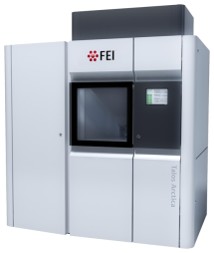 Model: Talos Arctica / Image courtesy: FEI Company |
|---|---|
| Microscopy | Model: FEI TALOS ARCTICA |
| Electron gun | Electron source:  FIELD EMISSION GUN / Accelerating voltage: 200 kV / Illumination mode: FLOOD BEAM FIELD EMISSION GUN / Accelerating voltage: 200 kV / Illumination mode: FLOOD BEAM |
| Electron lens | Mode: BRIGHT FIELD / Nominal magnification: 57000 X / Nominal defocus max: 1600 nm / Nominal defocus min: 600 nm / Cs: 2.7 mm / C2 aperture diameter: 50 µm / Alignment procedure: COMA FREE |
| Specimen holder | Cryogen: NITROGEN / Specimen holder model: FEI TITAN KRIOS AUTOGRID HOLDER |
| Image recording | Average exposure time: 6 sec. / Electron dose: 55 e/Å2 / Film or detector model: GATAN K3 (6k x 4k) / Num. of grids imaged: 1 / Num. of real images: 9094 |
- Processing
Processing
| EM software |
| |||||||||||||||||||||||||||||||||||||||||||||||||||||||
|---|---|---|---|---|---|---|---|---|---|---|---|---|---|---|---|---|---|---|---|---|---|---|---|---|---|---|---|---|---|---|---|---|---|---|---|---|---|---|---|---|---|---|---|---|---|---|---|---|---|---|---|---|---|---|---|---|
| Image processing | Details: Images were motion corrected using patch motion correction software in CryoSPARC. | |||||||||||||||||||||||||||||||||||||||||||||||||||||||
| CTF correction | Type: PHASE FLIPPING AND AMPLITUDE CORRECTION | |||||||||||||||||||||||||||||||||||||||||||||||||||||||
| Particle selection | Num. of particles selected: 3153592 | |||||||||||||||||||||||||||||||||||||||||||||||||||||||
| Symmetry | Point symmetry: C3 (3 fold cyclic) | |||||||||||||||||||||||||||||||||||||||||||||||||||||||
| 3D reconstruction | Resolution: 2.48 Å / Resolution method: FSC 0.143 CUT-OFF / Num. of particles: 395423 / Algorithm: FOURIER SPACE / Num. of class averages: 1 / Symmetry type: POINT | |||||||||||||||||||||||||||||||||||||||||||||||||||||||
| Atomic model building | B value: 58.4 / Protocol: RIGID BODY FIT / Space: REAL / Target criteria: Cross-correlation coefficient Details: Model was fit to map using ChimeraX fitmap, and then refined in PHENIX. | |||||||||||||||||||||||||||||||||||||||||||||||||||||||
| Atomic model building | PDB-ID: 7STW Accession code: 7STW / Source name: PDB / Type: experimental model | |||||||||||||||||||||||||||||||||||||||||||||||||||||||
| Refinement | Cross valid method: NONE |
 Movie
Movie Controller
Controller





 PDBj
PDBj


